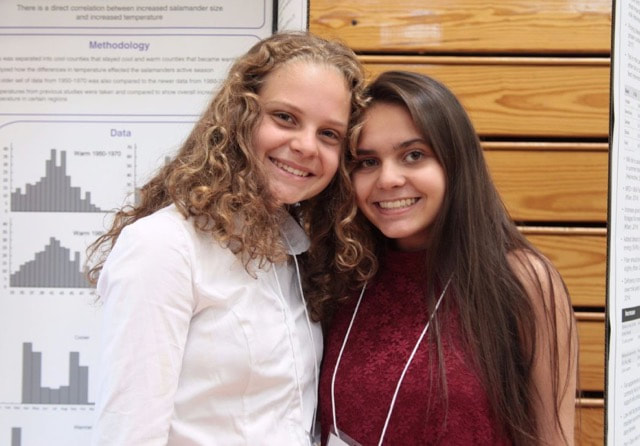Emma Jones '19
Title: Differential Decomposition of a Single Diptera Species (Sarcophagidae) versus a Community of Diptera Species (Calliphoridae)
Problem:
The testing of current entomologists fails to take into account the interspecies competition present on decomposing carcasses. Many experiments analyze the effects of certain factors, such as weather, location, or moisture, but these effects are looked at specifically to single species of diptera rather than a variety of species. Without taking into account the potential competition present in wildlife situation these results could be skewed and be detrimental in forensic investigations.
The goal of this project was to determine the average decomposition of single species (Sarcophaga bullata), determine the average decomposition of the Wildlife community species (Calliphoridae), and compare the average decomposition of the single versus community species.
Activities & Interests:
Emma is a member of the National Honors Society and National Art Honors Society. She works part time at the Primrose Elementary School YMCA as well as Bobo's Cafe in Somers, New York. Emma enjoys running, spending time with friends, and hiking. She will be attending the University of Vermont in the Honors College this fall. She was also a part of a group project with fellow senior Chelsea Brown.
Problem:
The testing of current entomologists fails to take into account the interspecies competition present on decomposing carcasses. Many experiments analyze the effects of certain factors, such as weather, location, or moisture, but these effects are looked at specifically to single species of diptera rather than a variety of species. Without taking into account the potential competition present in wildlife situation these results could be skewed and be detrimental in forensic investigations.
The goal of this project was to determine the average decomposition of single species (Sarcophaga bullata), determine the average decomposition of the Wildlife community species (Calliphoridae), and compare the average decomposition of the single versus community species.
Activities & Interests:
Emma is a member of the National Honors Society and National Art Honors Society. She works part time at the Primrose Elementary School YMCA as well as Bobo's Cafe in Somers, New York. Emma enjoys running, spending time with friends, and hiking. She will be attending the University of Vermont in the Honors College this fall. She was also a part of a group project with fellow senior Chelsea Brown.
Abstract:
Forensic diptera entomology is the study of flies as they decompose on carcasses, primarily used in forensic science to determine how long the organism these flies are inhabiting has been deceased. Decomposition rates can vary widely for numerous natural reasons, which are commonly studied by entomologists, along with comparing single species to each other. This study, in contrast, compares single species to a community of species to determine if there is a difference between decomposition rates when there are other fly species present versus when only one species is present. It was hypothesized that the single species, Sarcophaga bullata, would decompose at a faster rate than that of the community of Calliphoridae (Wildlife) species. In this study, the single species Sarcophaga bullata was used to represent the lab setting, and the community of Calliphoridae flies was used to represent the natural setting. Over the course of four months, ground beef was placed in fly cages and once removed, allowed to sit for two weeks. The initial and final weights were measured to determine the percentage of meat decomposed over this time period for each species. It was found that although the s. bullata had higher average decomposition rate, the p-value was over 0.05 (p = 0.416), meaning that there was not a statistical significance between the single species (lab setting) versus the community species (natural setting).
Forensic diptera entomology is the study of flies as they decompose on carcasses, primarily used in forensic science to determine how long the organism these flies are inhabiting has been deceased. Decomposition rates can vary widely for numerous natural reasons, which are commonly studied by entomologists, along with comparing single species to each other. This study, in contrast, compares single species to a community of species to determine if there is a difference between decomposition rates when there are other fly species present versus when only one species is present. It was hypothesized that the single species, Sarcophaga bullata, would decompose at a faster rate than that of the community of Calliphoridae (Wildlife) species. In this study, the single species Sarcophaga bullata was used to represent the lab setting, and the community of Calliphoridae flies was used to represent the natural setting. Over the course of four months, ground beef was placed in fly cages and once removed, allowed to sit for two weeks. The initial and final weights were measured to determine the percentage of meat decomposed over this time period for each species. It was found that although the s. bullata had higher average decomposition rate, the p-value was over 0.05 (p = 0.416), meaning that there was not a statistical significance between the single species (lab setting) versus the community species (natural setting).
| WRJSHS PowerPoint |
| WESEF Poster |




